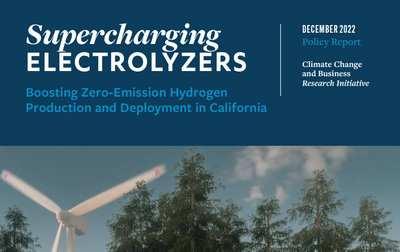 About the report: This policy report is part of a series on how specific sectors of the business community can drive key climate change solutions and how policymakers can facilitate those solutions. Each report results from workshop convenings that include expert representatives from the business, academic, policy, and environmental sectors. The convenings and resulting policy reports are sponsored by Bank of America and produced by a partnership of UC Berkeley School of Law’s Center for Law, Energy & the Environment (CLEE) and UCLA School of Law’s Emmett Institute on Climate Change and the Environment. AUTHORS Ethan N. Elkind CLIMATE CHANGE AND BUSINESS PROGRAM CENTER FOR LAW, ENERGY & THE ENVIRONMENT Ross Zelen RESEARCH FELLOW - CLIMATE CENTER FOR LAW, ENERGY & THE ENVIRONMENT. Additional contributions to the report were made by Sean Hecht and Cara Horowitz of UCLA School of Law. The authors also thank Hayley Lai (UC Berkeley Class of 2024) for her contributions to the report through her role as a research assistant at CLEE
About the report: This policy report is part of a series on how specific sectors of the business community can drive key climate change solutions and how policymakers can facilitate those solutions. Each report results from workshop convenings that include expert representatives from the business, academic, policy, and environmental sectors. The convenings and resulting policy reports are sponsored by Bank of America and produced by a partnership of UC Berkeley School of Law’s Center for Law, Energy & the Environment (CLEE) and UCLA School of Law’s Emmett Institute on Climate Change and the Environment. AUTHORS Ethan N. Elkind CLIMATE CHANGE AND BUSINESS PROGRAM CENTER FOR LAW, ENERGY & THE ENVIRONMENT Ross Zelen RESEARCH FELLOW - CLIMATE CENTER FOR LAW, ENERGY & THE ENVIRONMENT. Additional contributions to the report were made by Sean Hecht and Cara Horowitz of UCLA School of Law. The authors also thank Hayley Lai (UC Berkeley Class of 2024) for her contributions to the report through her role as a research assistant at CLEE
Introduction & Executive Summary
As California seeks to decarbonize its electricity grid and achieve carbon neutrality by 2045, hydrogen produced from zero-emission sources could play a critical role. The gas can generate electricity when solar or wind energy is unavailable, as well as power fuel-cell electric vehicles. Developers can harness surplus renewable energy to create it, resulting in zero-emission (sometimes referred to as “green”) hydrogen. Zero-emission hydrogen refers to the production and creation of hydrogen using only renewable energy resources. Electrolyzers, which separate water into oxygen and hydrogen, are critical to mass production of zero-emission hydrogen. As a result, zero-emission hydrogen depends on reducing the cost of electrolyzers, as well as ensuring access to low-cost renewable energy. California could be well positioned to leverage its renewable energy deployment and cleantech industry expertise to decrease these costs and create a sustainable industry of electrolysis-based zero-emission hydrogen.
Hydrogen is on pace for significant growth in the world energy marketplace. In 2020, global hydrogen demand reached 90 million tons.1 By 2050, forecasts indicate that demand for renewable or low-carbon hydrogen could reach 660 million tons, or 22% of total energy demand worldwide.2 In the U.S., the Infrastructure Investment and Jobs Act of 2021 and the Inflation Reduction Act of 2022 have spurred significant interest in hydrogen at all levels of government.3 With hydrogen likely to play a role in the ongoing economy-wide decarbonization process, California can help ensure that the future of this gas is truly zero-emission through state policies promulgated this decade.
Zero-emission electrolytic hydrogen has the potential to replace fossil gas in a myriad of applications, including hard-to-decarbonize industrial uses such as metals processing, cement production, and glass manufacturing, as well as a transportation fuel for heavy-duty goods movement (trucks, rail, and ships). The produced hydrogen can be distributed in pipelines or by truck, ship, or other means for immediate use. Hydrogen may also be stored in large quantities using natural underground caverns or massive tanks, to be utilized or converted back into electricity when needed. In this way, hydrogen could serve as long-term seasonal energy storage to help California’s electricity grid decarbonize by providing dispatchable, zero-emission power when the sun and wind are absent. Grid operators and project developers could utilize surplus renewable power (solar or wind) to create the hydrogen, helping to solve the issue of having to dump or “curtail” excess solar or wind energy produced during times of low demand.
Yet major hurdles remain to deployment. Most prominently, producing zero-emission hydrogen currently costs somewhere between two to three times more compared with hydrogen created from fossil-fuels.5 While analysts expect prices for electrolyzers to decrease this decade, zero-emission hydrogen will not achieve cost parity with fossil-based hydrogen absent significant market scale and policy support.6 Electrolyzers also have additional capital and operating costs, including water, reliance on intermittent power generation, and requirements for new storage infrastructure and distribution systems.
To address these challenges and opportunities, UC Berkeley School of Law’s Center for Law, Energy and the Environment (CLEE) and UCLA School of Law’s Emmett Institute on Climate Change and the Environment convened leaders from state and local government, electric utilities, and environmental organizations in Spring 2022 to examine opportunities to optimize deployment of zero-emission hydrogen electrolyzers to meet California’s climate goals.
Read the report: https://www.law.berkeley.edu/wp-content/uploads/2022/12/Supercharging-El...
